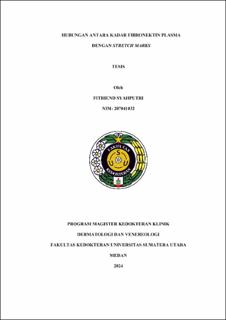Hubungan antara Kadar Fibronektin Plasma dengan Stretch Marks
Relationship between Plasma Fibronectin Levels and Stretch Marks

Date
2024Author
Syahputri, Fitriend
Advisor(s)
Putra, Imam Budi
Jusuf, Nelva Karmila
Metadata
Show full item recordAbstract
Background: Stretch marks or striae distensae are linear atrophic scars that form
in areas of skin damage as a result of skin stretching. Mast cell degranulation and
activation of macrophages occur as well as changes in the components of the
extracellular matrix, including fibronectin. Fibronectin as a dimeric glycoprotein
and components contained in the extracellular matrix, functions as a regulator of
cellular processes, to maintain tissue and functions in the process of wound healing
in tissues
Objective: To determine the relationship between plasma fibronectin levels and
stretch marks.
Subjects and Methods: This study was an observational study with a crosssectional
design involving 40 females with stretch marks and 40 females without
stretch marks who fulfilled inclusion and exclusion criteria in this study. Each
research subject underwent anamnesis, physical examination, dermatological
examination, and blood sampling to assess plasma fibronectin levels using the
ELISA test. These data were analyzed statistically using the Chi square test.
Results: In this study, it was found that the highest age for stretch marks was 18–
25 years, 33 people (82.5%). Most of them had a family history of stretch marks,
20 people (50%). The location where stretch marks occur mostly occurs in region
gluteus 10 people (25%). The average fibronectin level in stretch marks was
259.541 ng/mL. The results of this study showed that there was a relationship
between plasma fibronectin levels which caused a high risk of 2.85 times for stretch
marks
Conclusion: There was a relationship between plasma fibronectin levels and stretch
marks.
